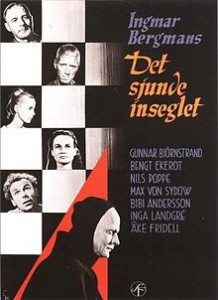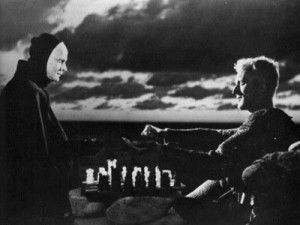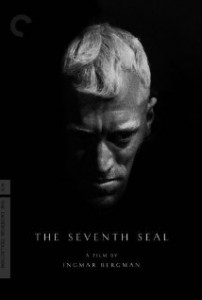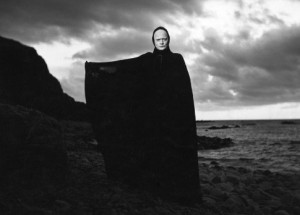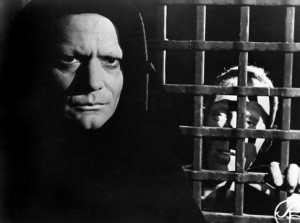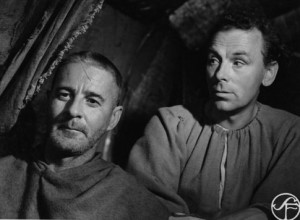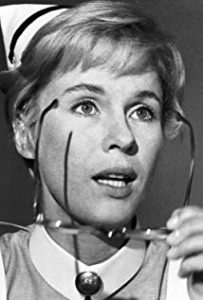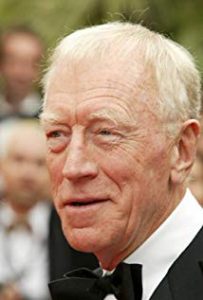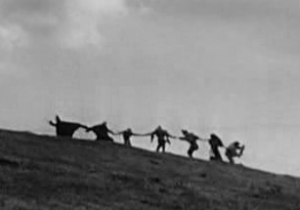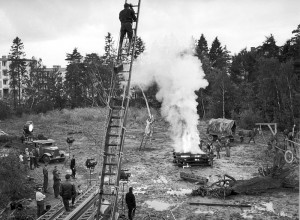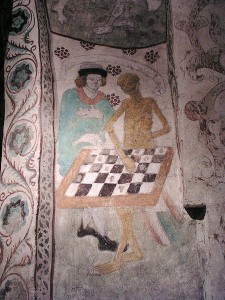The Seventh Seal ***** (1957, Max von Sydow, Gunnar Björnstrand, Bengt Ekerot, Bibi Andersson, Nils Poppe) – Classic Movie Review 1242
The majestic Swedish writer-director Ingmar Bergman’s 1957 masterwork The Seventh Seal is a major classic of world cinema. After 17 films as director, it established Bergman’s international reputation as a film-maker of world renown and art-house favourite.
It stars a commanding Max von Sydow as the medieval knight Antonius Block returning to Sweden during the Black Death with his nihilistic squire Jöns (Gunnar Björnstrand) from the Crusades. Block discovers that his homeland has been completely wasted by the plague.
He finds that the personification of Death (Bengt Ekerot) has come to take his life and, in one of cinema’s most striking (and parodied) ideas, he challenges Death to a life or death chess game. When Death agrees and they choose sides for the chess game, Death gets the black pieces of course.
Basing his screenplay on his own 1953 play Trämålning (Wood Painting), Bergman confronts many of his favourite topics, among them religion, God and mortality. Alongside the brilliantly realised allegory, Bergman paints a flamboyant picture of medieval society devastated by plague and turmoil. Some of the iconic shots are over-familiar through countless parodies and homages, but they still reverberate mightily in context and The Seventh Seal contains scenes which have become the most famous in world cinema.
The Seventh Seal is one of Bergman’s greatest and most accessible films with a towering performance from von Sydow and famous, haunting images, lovingly photographed by master cinematographer Gunnar Fischer in a masterpiece of cinematography.
The title refers to a passage from the Book of Revelation, used at the start and towards the end of the film: ‘And when the Lamb had opened the seventh seal, there was silence in heaven about the space of half an hour.’ Here the motif of silence refers to the ‘silence of God’, a major theme of the film.
Bergman originally wrote the play Trämålning for the acting students of Malmö City Theatre. The first time it was performed in public was on radio in 1954, directed by Bergman. He then directed it on stage in Malmö the next spring, and in the autumn it was staged in Stockholm, directed by Bengt Ekerot who plays Death in the film.
Bergman rewrote the script five times and was given a shooting schedule of only 35 days and a budget of $150,000 by Svensk Filmindustri, who at first rejected the film but changed their mind after the success at the Cannes Film Festival of Bergman’s Smiles of a Summer Night in 1955.
Much of the film’s imagery is derived from medieval art. Bergman stated that the image of a man playing chess with a skeletal Death was inspired by a medieval church painting from the 1480s in Täby kyrka, Täby, north of Stockholm, painted by Albertus Pictor.
Bergman doesn’t intend historical accuracy, only metaphorical accuracy. The third and last Swedish crusade took place in 1293 but the Black Death hit Europe in 1348. The flagellant movement shown in the film was foreign to Sweden, and large-scale witch persecutions only began in the 15th century.
RIP Bibi Andersson, who plays Mia, the wife of Jof (Nils Poppe). She died on 14 aged 83. She is also known for Bergman’s Wild Strawberries (1957) and Persona (1966).
RIP Max von Sydow, who died on 8 aged 90.
© Derek Winnert 2014 Classic Movie Review 1242
Link to Derek Winnert’s home page for more film reviews: http://derekwinnert.com/
The final scene depicting the danse macabre, as the knight and his followers are led away over the hills in a solemn dance of death.
Filming of The Seventh Seal in and around the Filmstaden studios in Solna.
Death playing chess, from Täby Church, fresco by Albertus Pictor.

